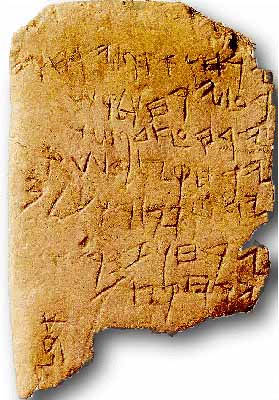

It is feasible that since human beings became aware of their environment (in whatever stage of human development it occurred), one of the first thing that must have impressed them very much were the changes that are continually taking place in the world around them. These changes had to be adjusted to, and this idea is beautifully expressed in the Old Testament book of Ecclesiastes 3, 1-2: "To everything there is a season, and a time to every purpose under the heaven... A time to be born and a time to die; a time to plant and a time to pluck up the planted..." etc.
For early farmers it was very important to know when to do the various works in fields and gardens, so as to make sure they got the best crop they could. A very basic farming calendar was found carved in stone on the site of the ancient Israelite town of Gezer, possibly written by a student:
'sf — 2 months of ingathering (September-October — Autum equinox)
q'l — 2 months of early sowing (November-December — Winter solstice)
lqsh — 2 months of late sowing (January-February)
'tzd psht — 1 month of flax plucking (March — Spring equinox)
qtzr sr — 1 month of barley harvest (April)
qtzr kl — 2 months of the rest of harvest (May-June — Summer solstice)
zmr — 1 month of grape harvest (July)
qtz — last month of late fruit harvest (August)
Interestingly, the names of these months, that express the farm works done in them, do not correspond to any of the traditional names of the Israelite year, either native or Babylonian.

The most ancient counting of changes in Nature, though, is considered to be the phases of the moon. At an Internet site called The Moon in Ancient History — Ancient Astronomical Calendars we can read:
"There are 'Man made' lunar calendars that some scientists place as old as 32,000 years. Some recent archeological findings are from the Ice Age where hunters carved notches and gouged holes into sticks, reindeer bones and the tusks of mammoths, depicting the days between each phase of the Moon."
This continuous change that never alters in one of the most sacred objects of human beliefs — the Moon — must have left a strong impression on all peoples around the world. So much so that, as far as is known to historians, all earlier calendars were lunar in nature. The word "calendar" itself seems to derive from the Latin word "kalendae", referring to the first day of every month.
The following peoples are among those who are known to initially have a lunar calendar, and some of them still use it today: Ancient Egyptian, Babylonian, Greek, Roman, Anglo-Saxon, Hindu, Chinese, Mayan, the Celts, Jews and Muslims.






















